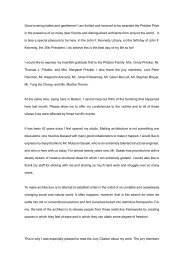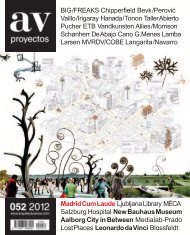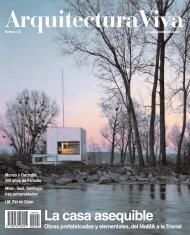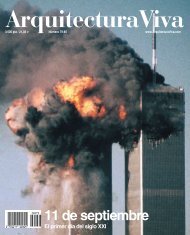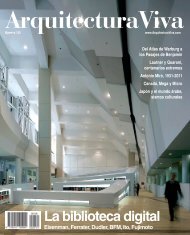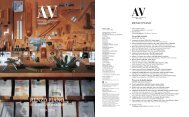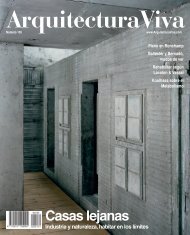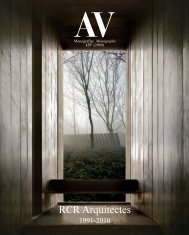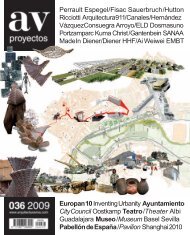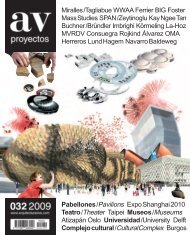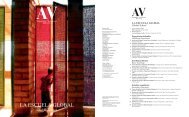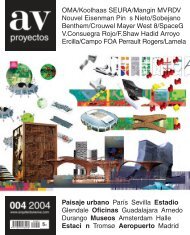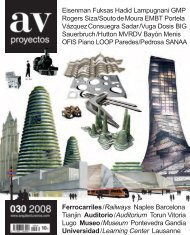Cumbres borrascosas - Arquitectura Viva
Cumbres borrascosas - Arquitectura Viva
Cumbres borrascosas - Arquitectura Viva
Create successful ePaper yourself
Turn your PDF publications into a flip-book with our unique Google optimized e-Paper software.
<strong>Arquitectura</strong><strong>Viva</strong><br />
Número 146 www.<strong>Arquitectura</strong><strong>Viva</strong>.com<br />
13ª Bienal de Venecia<br />
De Babel a Dubái,<br />
el mito vertical<br />
Arte en el paisaje:<br />
Gori y Château La Coste<br />
Solar Decathlon 2012<br />
Gran altura<br />
SOM, Piano, Gehry, OMA: rascacielos globales<br />
<strong>Cumbres</strong> <strong>borrascosas</strong><br />
La tormenta económica se dibuja en los perfiles urbanos con la habitual cosecha de<br />
rascacielos crepusculares: las cumbres construidas son financieramente <strong>borrascosas</strong>.<br />
Como ya ocurriera en la Gran Depresión iniciada en 1929, o en la resultante de las crisis<br />
del petróleo en 1973 y 1979, la Gran Recesión inaugurada con el colapso de Lehman<br />
en 2008 —que entra en su quinto año sin que se adviertan signos de recuperación—<br />
se marca en el paisaje con colosos gestados en la etapa de expansión, y una nueva<br />
colección de proyectos se sitúa ya en la línea de salida para, apenas las circunstancias<br />
lo permitan, superar a los anteriores en altura o singularidad. A título de ejemplo, aquí<br />
se han elegido cuatro obras y cuatro proyectos que jalonan el planeta siguiendo el curso<br />
mítico de las civilizaciones, desde el Oriente Medio donde nació la cultura urbana y la<br />
Europa donde se desarrolló de forma esplendorosa hasta la América que fue cuna de la<br />
edificación en altura y el continente asiático que ahora protagoniza el mayor empeño<br />
de creación de ciudades que haya conocido la historia: el Burj Khalifa de Dubái, hoy el<br />
techo del mundo, y cuyo arquitecto Adrian Smith —que dejó SOM para abrir su propia<br />
firma— propone dejar atrás con un proyecto visionario en Arabia Saudí; el Shard de<br />
Renzo Piano en Londres, récord de altura de la Unión Europea hasta que Norman Foster<br />
levante en París las dos torres del Hermitage Plaza; la torre Beekman de Frank Gehry, el<br />
edificio residencial más alto de Nueva York, y un experimento formal comparable al aún<br />
más inesperado rascacielos de BIG en Vancouver, que se abraza a una autopista elevada;<br />
y el icónico edificio CCTV de OMA/Rem Koolhaas en Pekín, cuya extravagancia quizá<br />
sólo podría sobrepasar la misma China con el cromlech de torres de la que forman parte<br />
las dos proyectadas por Eduardo Souto de Moura.<br />
Por una serie de azares, he podido visitar los cuatro rascacielos documentados aquí,<br />
y todos dejan en la memoria una sensación agridulce. El Burj Khalifa es el objeto<br />
más antiurbano e inaccesible que cabe imaginarse, aislado de curiosos o turistas por<br />
un amplio perímetro de exclusión, de manera que resulta onírico en la distancia y<br />
tan hostil en la cercanía como una fortaleza inexpugnable; sin embargo, el itinerario<br />
para las visitas pagadas es elegante y pedagógico, muestra bien el ingenio técnico y<br />
el refinamiento de detalle característicos de SOM, permitiendo acceder a las vistas<br />
desoladas que ofrecen sus alturas. No menos refinado es el Shard, cuya construcción ha<br />
hecho entender mejor el desconcertante proyecto exfoliado, y que hoy se levanta sobre<br />
una zona anónima de Londres con voluntad lograda de hito ciudadano, pese a que la<br />
inserción en el entorno próximo de su titánica base hace echar de menos la ingrávida<br />
llegada al suelo del rascacielos del propio Piano para el New York Times. En la misma<br />
Manhattan, Gehry ha mostrado su inteligencia pragmática con una torre que traslada su<br />
lenguaje a la construcción en altura sin alterar su lógica estructural, que se integra en el<br />
perfil de la ciudad con naturalidad y distinción, y que al tiempo acepta los compromisos<br />
de negociación urbanística para desfigurar o negar su condición en el decepcionante<br />
arranque. Y en Pekín, por último, el deplorable diálogo de la sede de CCTV con el<br />
ámbito inmediato, amén de la gratuidad de su gesto, se torna en seducción cuando sus<br />
volúmenes insólitos se recortan sobre los muros de la Ciudad Prohibida, la obra de<br />
OMA devenida felizmente logo de una institución, una ciudad o un tiempo: como tantas<br />
otras, le pierde la cercanía y le salva la distancia. La misma acaso que necesitamos para<br />
sobrevivir al trayecto por estas cumbres <strong>borrascosas</strong>.<br />
Luis Fernández-Galiano<br />
The economic storm is marked on skylines with the<br />
usual crop of twilight towers: financial wuthering<br />
heights. As in the Great Depression of 1929, or in<br />
the one after the oil crises of 1973 and 1979, the<br />
Great Recession triggered by the collapse of Lehman<br />
in 2008 is made visible with skyscrapers started<br />
in the boom years, and a new series of projects is<br />
already on the boards, ready to surpass its forbears<br />
in height or singularity. By way of example, the<br />
following pages include four works and four projects<br />
that circle the planet following the mythical course<br />
of civilizations, from the Middle East, where urban<br />
culture was born, and Europe, where it flourished,<br />
to America, the cradle of skyscrapers, and Asia,<br />
scenario of the largest urban effort ever: the Burj<br />
Khalifa in Dubai, the roof of the world, and whose<br />
designer Adrian Smith – who left SOM to set up his<br />
own firm – intends to beat with a visionary project<br />
in Saudi Arabia; The Shard by Renzo Piano in<br />
London, the EU height record until Norman Foster<br />
raises in Paris the two towers of the Hermitage<br />
Plaza; the Beekman Tower by Frank Gehry, the<br />
tallest residential building in New York, and a<br />
formal experiment comparable to the even more<br />
unexpected skyscraper by BIG in Vancouver; and<br />
the iconic CCTV building by OMA in Beijing, whose<br />
extravagance might only be exceeded by China<br />
itself with the cromlech of towers that includes two<br />
designed by Souto de Moura.<br />
I have had the chance to visit the four towers<br />
featured here, and they all leave a bittersweet taste.<br />
The Burj Khalifa is the most antiurban object one<br />
can imagine, isolated from onlookers and tourists<br />
by a broad exclusion zone, so its dreamlike image<br />
from afar becomes hostile when near; however,<br />
the itinerary for paid visits is instructive, showing<br />
the constructive finesse of SOM, and leading to the<br />
desolate views from its top floors. No less refined is<br />
The Shard, better built than as a project, and that<br />
rises today in a non-descript area of London as a<br />
fine urban landmark, even if the way its titanic base<br />
sits in its immediate context makes one miss the<br />
weightless landing of another skyscraper by Piano,<br />
that for the NYT. Also in Manhattan, Gehry has<br />
showed his pragmatic intelligence with a tower that<br />
translates his language to high-rise construction<br />
without altering its structural logic, and that fits into<br />
the skyline with ease and distinction, although urban<br />
negotiation has disfigured or denied its condition<br />
in the disappointing base. And in Beijing, lastly, the<br />
poor dialogue of the CCTV building with its close<br />
context, aside from the arbitrary formal gesture,<br />
becomes seduction when its surprising volume is<br />
seen from the interior of the Forbidden City, OMA’s<br />
work happily becoming the logo of an institution, a<br />
city or a time: as many others, it looks better from a<br />
distance than up close. The same distance we need to<br />
survive the journey through these wuthering heights.<br />
<strong>Arquitectura</strong><strong>Viva</strong> 146 2012 3
Director<br />
Luis Fernández-Galiano<br />
Director adjunto<br />
José Jaime S. Yuste<br />
Diagramación y redacción<br />
Cuca Flores<br />
Raquel Congosto<br />
Laura Fernández<br />
Eduardo Prieto<br />
Lys Villalba<br />
Pablo del Ser<br />
Maite Báguena<br />
David Cárdenas<br />
Raquel Vázquez<br />
Miguel Fernández-Galiano<br />
Coordinación editorial<br />
Laura Mulas<br />
Gina Cariño<br />
Producción<br />
Laura González<br />
Jesús Pascual<br />
Administración<br />
Francisco Soler<br />
Suscripciones<br />
Lola González<br />
Distribución<br />
Mar Rodríguez<br />
Publicidad<br />
Cecilia Rodríguez<br />
Redacción y administración<br />
<strong>Arquitectura</strong> <strong>Viva</strong> SL<br />
Aniceto Marinas, 32<br />
E-28008 Madrid<br />
Tel: (+34) 915 487 317<br />
Fax: (+34) 915 488 191<br />
AV@<strong>Arquitectura</strong><strong>Viva</strong>.com<br />
www.<strong>Arquitectura</strong><strong>Viva</strong>.com<br />
Precio: 18 euros<br />
© <strong>Arquitectura</strong> <strong>Viva</strong><br />
Depósito legal: M. 17.043/1988<br />
ISSN: 0214-1256<br />
Distribución en quioscos: Logintegral<br />
Impresión: Artes Gráficas Palermo, S.L.<br />
Cubierta: Panorámica de Londres<br />
Foto: Jason Hawkes Aerial Photography<br />
Traducciones: E. Prieto (Ingersoll);<br />
L. Mulas (inglés)<br />
<strong>Arquitectura</strong><br />
<strong>Viva</strong>.com<br />
Número 146<br />
Gran altura. Con el atentado de las Torres Gemelas de Nueva York, muchos<br />
auguraron el fin de los rascacielos. Sin embargo, más de una década después de<br />
aquella tragedia, la edificación de gran altura goza de buena salud, alimentada<br />
tanto por cambios formales y técnicos como por el estímulo inversor de una<br />
época de desarrollo económico que ha propiciado el crecimiento acelerado de<br />
los países emergentes. Dos artículos, acompañados por una selección de cuatro<br />
proyectos, dan cuenta de las innovaciones constructivas y los roles simbólicos<br />
de los rascacielos en el contexto de las sociedades contemporáneas.<br />
Obras / Proyectos<br />
Rascacielos globales. La primera década del siglo xxi no sólo ha asistido a<br />
la construcción de los rascacielos más grandes de la historia, sino a la mutación<br />
formal y estructural de los viejos tipos. Se recogen aquí cuatro hitos, ordenados<br />
por su altura, de un periplo que, desde el golfo Pérsico llega al extremo Oriente,<br />
pasando por Europa y América: el Burj Khalifa en Dubái, una Babel construida<br />
por SOM y que, con sus 828 metros de altura, es hoy el techo edificado del<br />
mundo; la cristalina Torre London Bridge de Renzo Piano, que corona la silueta<br />
de la capital londinense y es el edificio más alto de la Unión Europea; la<br />
Torre Beekman de Frank Gehry, en Nueva York, con su alabeada envolvente<br />
de acero inoxidable; y, finalmente, la sede de la CCTV en Pekín, de OMA/<br />
Rem Koolhaas, con sus voladizos expresionistas y su innovador exoesqueleto.<br />
Arte / Cultura<br />
Común y vertical. La 13ª edición de la Bienal de <strong>Arquitectura</strong> de Venecia ha<br />
tratado el tema de lo común; por su parte, los rascacielos en la historia son el argumento<br />
de una exposición en las sedes barcelonesa y madrileña del CaixaForum.<br />
Colecciones de bolsillo. La Fattoria di Celle, de la que se cumplen treinta<br />
años, y Château La Coste, son dos colecciones privadas, casi secretas, que tienen en<br />
común la calidad de sus fondos y su singular manera de presentarlos en el paisaje.<br />
El poder de las imágenes. Luis Fernández-Galiano reseña dos libros<br />
sobre Le Corbusier como conferenciante y fotógrafo. Además, recensiones<br />
sobre Charles Correa, Mike Davies, Paul Ott y la joven arquitectura japonesa.<br />
Técnica / Construcción<br />
Innovación en detalle. El análisis técnico de la competición universitaria<br />
Solar Decathlon, cuya segunda edición europea se ha celebrado recientemente<br />
en Madrid, abre esta sección, en la que se incluye también la quinta entrega de<br />
la serie Filtros, sobre las galerías, pérgolas y otros espacios intermedios en la<br />
arquitectura. Se publica también un artículo sobre la influencia del campo magnético<br />
en la construcción, acompañado de un elenco de productos organizados<br />
por categorías, entre ellos ventanas con gran capacidad de aislamiento, fachadas<br />
con refrigeración evaporativa, módulos industrializados, losas estructurales<br />
con incorporación de instalaciones, así como aireadores y aerogeneradores.<br />
Para terminar, Eduardo Mangada advierte de las consecuencias que, desde<br />
el punto de vista urbano, tendrían para Madrid los Juegos Olímpicos y Eurovegas.<br />
15 Iñaki Ábalos<br />
Energía y capitalismo<br />
Monstruos termodinámicos<br />
18 Ramón Araujo<br />
El precio de la altura<br />
Técnica y nuevos rascacielos<br />
24 Hipótesis verticales<br />
Cuatro proyectos<br />
Smith, Foster, BIG, S. de Moura<br />
34 SOM<br />
Burj Khalifa<br />
Dubái, EAU<br />
40 Renzo Piano<br />
Torre London Bridge<br />
Londres, Reino Unido<br />
48 Frank Gehry<br />
Torre Beekman<br />
Nueva York, EE UU<br />
54 OMA/Rem Koolhaas<br />
Edificio CCTV<br />
Pekín, China<br />
65 Richard Ingersoll<br />
Vanguardia y ‘déjà vus’<br />
68 Eduardo Prieto<br />
De Babel a Dubái<br />
70 Kosme de Barañano<br />
‘Folies’ verdes<br />
72 Marina Otero<br />
125 hectáreas de arte<br />
74 Historietas de Focho<br />
Gran altura<br />
75 Autores varios<br />
Libros<br />
84 AA. VV.<br />
Solar Decathlon 2012<br />
100 Paricio y Pardal<br />
Interiores al aire libre<br />
De Coderch a Lacaton & Vassal<br />
103 Innovación<br />
Campo magnético<br />
Envolventes<br />
Industrialización<br />
Estructuras<br />
112 Eduardo Mangada<br />
La no ciudad<br />
15 Iñaki Ábalos<br />
Energy and Capitalism<br />
Thermodynamic Monsters<br />
18 Ramón Araujo<br />
The Price of Height<br />
Technique and New Towers<br />
24 Vertical Hypotheses<br />
Four Projects<br />
Smith, Foster, BIG, Souto<br />
34 SOM<br />
Burj Khalifa<br />
Dubai, UAE<br />
40 Renzo Piano<br />
London Bridge Tower<br />
London, United Kingdom<br />
48 Frank Gehry<br />
Beekman Tower<br />
New York, USA<br />
54 OMA/Rem Koolhaas<br />
CCTV Building<br />
Beijing, China<br />
65 Richard Ingersoll<br />
Vanguard and ‘déjà vus’<br />
68 Eduardo Prieto<br />
From Babel to Dubai<br />
70 Kosme de Barañano<br />
Green ‘Folies’<br />
72 Marina Otero<br />
125 Hectares of Art<br />
74 Focho’s Cartoon<br />
High-Rise<br />
75 Various Authors<br />
Books<br />
84 VV. AA.<br />
Solar Decathlon 2012<br />
100 Paricio & Pardal<br />
Outdoor Interiors<br />
Filters Series<br />
103 Innovation<br />
Magnetic Field<br />
Enclosures<br />
Industrialization<br />
Structures<br />
112 Eduardo Mangada<br />
The Non-City<br />
Number 146<br />
High-Rise. With the attack on the Twin Towers in New York, many predicted<br />
the end of skyscrapers. However, more than a decade after the tragedy,<br />
high-rise construction is in very good health, fueled by formal and technical<br />
changes as well as by the strong investments made during a period of economic<br />
development which has triggered the fast-paced growth of emerging<br />
countries. Two articles, followed by a selection of four projects, review the<br />
building innovations and the symbolic roles taken on by skyscrapers in the<br />
context of our contemporary societies.<br />
Works / Projects<br />
Global Skyscrapers. The first ten years of the 21st century have witnessed<br />
the completion of the biggest skyscrapers of all times, and also the formal<br />
and structural mutation of the old types. This section includes four landmarks<br />
which, arranged by height, trace an itinerary that begins in the Persian Gulf and<br />
reaches the Far East, passing through Europe and America: the Burj Khalifa in<br />
Dubai, a Babel built by SOM and that is today’s roof of the world with its 828<br />
meters; the crystalline London Bridge Tower by Renzo Piano, which crowns<br />
London’s skyline and is currently the tallest building in the European Union;<br />
the Beekman Tower By Frank Gehry, in New York, with its warped stainless<br />
steel enclosure; and, finally, the CCTV headquarters in Beijing, by OMA/Rem<br />
Koolhaas, with its expressionist cantilevers and its innovative exoskeleton.<br />
Art / Culture<br />
Common and Vertical. The 13th Architecture Biennial of Venice has dealt<br />
with the subject of the common; furthermore, the skyscraper throughout history<br />
is the theme of the exhibition held at Madrid and Barcelona’s CaixaForums.<br />
Pocket Collections. La Fattoria di Celle, founded thirty years ago, and<br />
Château La Coste, are two private, almost secret collections characterized by the<br />
quality of their pieces and the unique way of presenting them in the landscape.<br />
The Power of Images. Luis Fernández-Galiano reviews two books on Le<br />
Corbusier as lecturer and photographer. Moreover, texts on Charles Correa,<br />
Mike Davies, Paul Ott, Aitor Ortiz and young Japanese architecture.<br />
Technique / Construction<br />
Innovation in Detail. This section begins with the technical analysis of<br />
the Solar Decathlon collegiate competition, whose second European edition<br />
was held recently in Madrid, and continues with the fifth piece in the Filters<br />
Series, devoted to galleries, pergolas and other intermediate spaces in architecture,<br />
from Coderch to Lacaton & Vassal. It also includes an article about<br />
the influence of the magnetic field in construction, followed by a repertoire<br />
of products organized in categories, among them highly insulating windows,<br />
facades with evaporative cooling systems, industrialized modules, structural<br />
slabs with embedded services, aeration and wind turbines.<br />
To close, Eduardo Mangada warns about the urban impact that hosting the<br />
Olympic Games or building Eurovegas would have on the city of Madrid.



